L14-可数与不可数的相对性 初中英语词性句法新讲课件(共15张PPT)
文档属性
| 名称 | L14-可数与不可数的相对性 初中英语词性句法新讲课件(共15张PPT) | 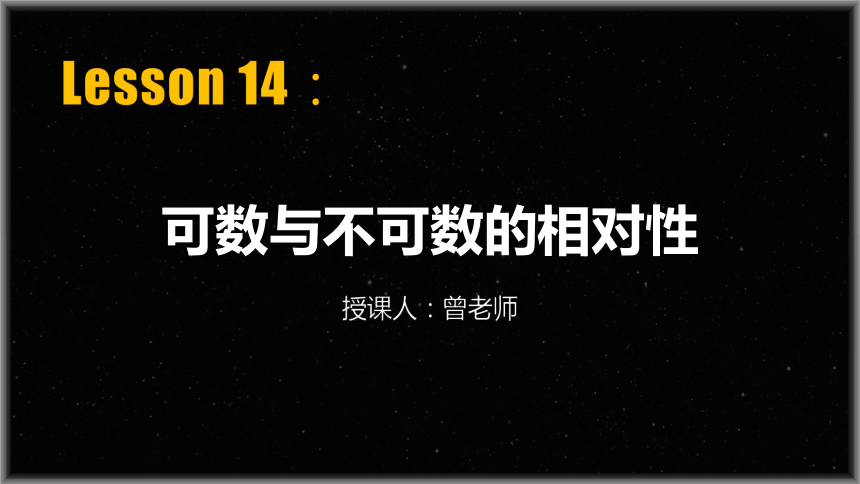 | |
| 格式 | ppt | ||
| 文件大小 | 2.2MB | ||
| 资源类型 | 试卷 | ||
| 版本资源 | 通用版 | ||
| 科目 | 英语 | ||
| 更新时间 | 2022-04-10 22:21:49 | ||
图片预览

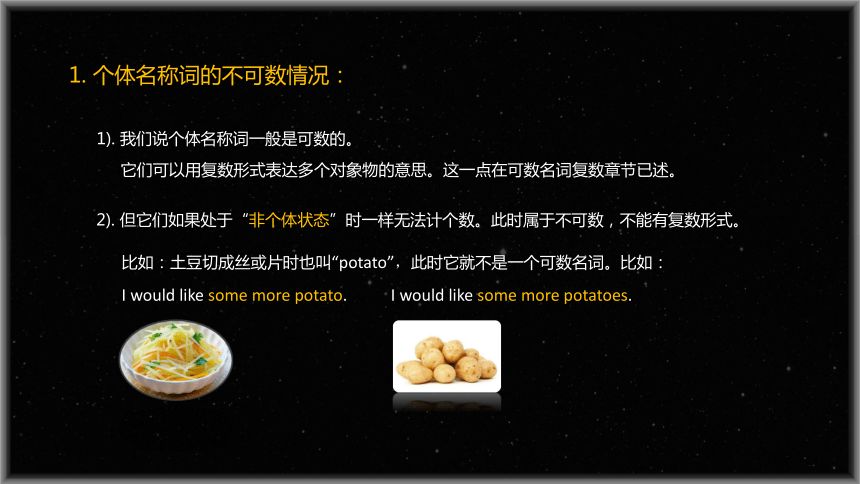
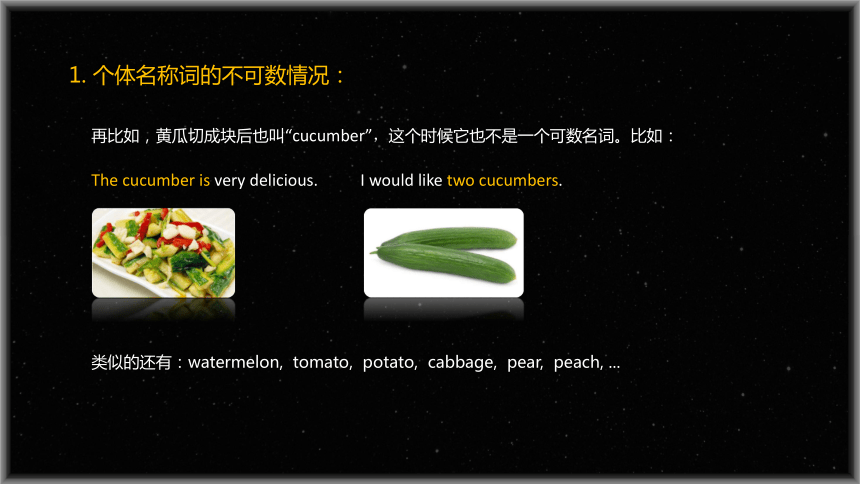

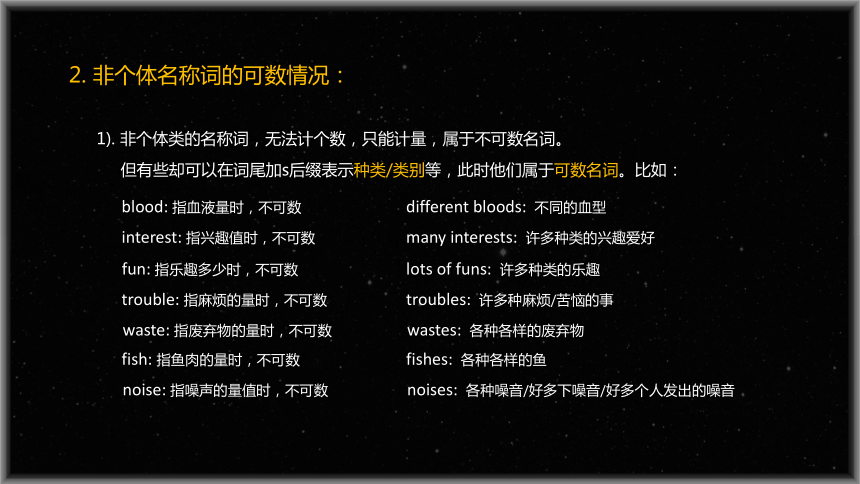

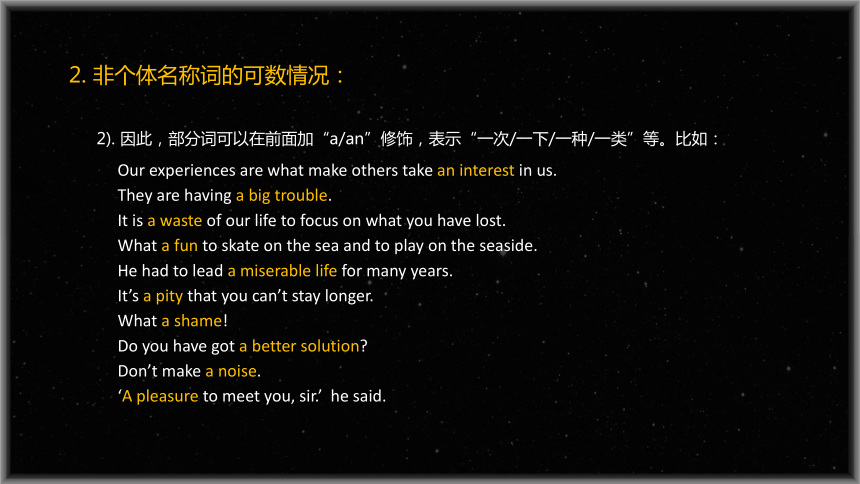
文档简介
(共15张PPT)
可数与不可数的相对性
Lesson 14:
授课人:曾老师
1). 我们说个体名称词一般是可数的。
它们可以用复数形式表达多个对象物的意思。这一点在可数名词复数章节已述。
1. 个体名称词的不可数情况:
2). 但它们如果处于“非个体状态”时一样无法计个数。此时属于不可数,不能有复数形式。
比如:土豆切成丝或片时也叫“potato”,此时它就不是一个可数名词。比如:
I would like some more potato.
I would like some more potatoes.
1. 个体名称词的不可数情况:
再比如,黄瓜切成块后也叫“cucumber”,这个时候它也不是一个可数名词。比如:
The cucumber is very delicious.
I would like two cucumbers.
类似的还有:watermelon, tomato, potato, cabbage, pear, peach, ...
3). 注意区分以下句子当中名词所使用的不同形式:
She bought two cabbages in the market.
Please get some cabbage for your salad.
I need three pears.
Take some pear after lunch.
1. 个体名称词的不可数情况:
There are two watermelons on the table.
There isn’t any watermelon on the dish.
1). 非个体类的名称词,无法计个数,只能计量,属于不可数名词。
但有些却可以在词尾加s后缀表示种类/类别等,此时他们属于可数名词。比如:
blood: 指血液量时,不可数
different bloods: 不同的血型
interest: 指兴趣值时,不可数
many interests: 许多种类的兴趣爱好
fun: 指乐趣多少时,不可数
lots of funs: 许多种类的乐趣
trouble: 指麻烦的量时,不可数
troubles: 许多种麻烦/苦恼的事
waste: 指废弃物的量时,不可数
wastes: 各种各样的废弃物
fish: 指鱼肉的量时,不可数
fishes: 各种各样的鱼
2. 非个体名称词的可数情况:
noise: 指噪声的量值时,不可数
noises: 各种噪音/好多下噪音/好多个人发出的噪音
2. 非个体名称词的可数情况:
Is there enough room for me in the car
I will book 3 rooms.
He spent much time on his collections.
Once upon a time, ...
He checked the times of trains on the computer.
He has much interest in Maths.
He has many interests.
实例区分:
eat lots of fruit and vegetables
2). 因此,部分词可以在前面加“a/an”修饰,表示“一次/一下/一种/一类”等。比如:
Our experiences are what make others take an interest in us.
They are having a big trouble.
It is a waste of our life to focus on what you have lost.
What a fun to skate on the sea and to play on the seaside.
He had to lead a miserable life for many years.
It’s a pity that you can’t stay longer.
What a shame!
Do you have got a better solution
Don’t make a noise.
‘A pleasure to meet you, sir.’ he said.
2. 非个体名称词的可数情况:
3). 也有部分非个体类的名称词,在词尾加s后缀表示“量大量多”。
这部分内容在“名词加s表述的含义”章节中进一步说明。
2. 非个体名称词的可数情况:
4). 也有部分词形成习惯后将指代“量词”省略,前面就留“a/an”进行修饰。比如:
I invited him back to my flat for a coffee. a cup of coffee
3. 个体与非个体的相对性:
Do you want some chocolate
We send him a box of chocolates.
▲ 英文中有很多名称词,它们既可以个体方式呈现,此时它们可数。同时也可以非个体的方式
呈现,此时它们可数。比如:
类似的还有:ice-cream, cake, ice, ...
3. 个体与非个体的相对性:
3). 注意区分以下句子当中名词所使用的不同形式:
I can go to the shop for an ice cream.
Don’t eat too much ice cream.
4. 一词多义情况:
有些名词是一词多义的,如果其指的对象无法计个体实数,只能计量,属于不可数名词。
但如果指的对象物是个体性的,此时他们属于可数名词。比如:
cotton: 指棉花团时,不可数
指树上的棉花时,可数
chicken: 指鸡肉时,不可数
指成只的鸡时,可数
work: 指要干的活时,不可数
指作品时,可数
experience: 指经验时,不可数
指经历时,可数
fish: 指鱼肉时,不可数
指整条的鱼时,可数
glass: 指玻璃时,不可数
指玻璃杯/眼镜时,可数
exercise: 指锻炼量时,不可数
指习题/锻炼次数时可数,可数
4. 一词多义情况:
light: 指光线时,不可数
指灯时,可数
age: 指年龄时,不可数
指年代时,可数
life: 指生活时,不可数
指生命时,可数
thought: 指思想的量时,不可数
指个人想法的个数时,可数
paper: 指纸时,不可数
指试卷/报纸/标准规格纸(比如A4规格)时,可数
这样的词还有很多,此不一一叙述。
所以:
简单粗暴地说一个名词是“可数”的,或是“不可数”的,这是不确切的。
5. 可数与不可数的判断标准:
综上所述,名词可数与不可数,基于该名称物展示时,是否是以“个体”方式呈现的。
* 如果属于“是”这种情况:就是可数的;
* 如果属于“不是”:就是不可数的。
6. 可数与不可数具体分析:
a pig: 一只猪,可数
some pork: 一些猪肉,不可数
根据这个标准:
two ducks: 二只鸭,可数
some roast duck with orange sauce: 一些烤鸭蘸橘子酱,不可数
a chocolate cake: 可数
a piece of cake: 不可数
two chickens: 二只鸡,可数
some chicken: 一些鸡肉,不可数
尤其要注意同形多义词
five fish: 五条鱼,可数(单复同形)
some fish: 一些鱼(可数),或一些鱼肉(不可数)
6. 可数与不可数具体分析:
Fog and low cloud cover are expected this afternoon. The sun went behind a cloud.
The sun burst through the clouds.
I will go to have my hair cut this afternoon.
There’s a hair in my soup.
The trees were swaying(摇晃) in the wind.
There was a strong/light wind blowing.
The winds of change are blowing across the country.
Watching TV brings us much pleasure.
‘A pleasure to meet you, sir.’ he said.
It was she who first introduced the pleasures of sailing to me.
可数与不可数的相对性
Lesson 14:
授课人:曾老师
1). 我们说个体名称词一般是可数的。
它们可以用复数形式表达多个对象物的意思。这一点在可数名词复数章节已述。
1. 个体名称词的不可数情况:
2). 但它们如果处于“非个体状态”时一样无法计个数。此时属于不可数,不能有复数形式。
比如:土豆切成丝或片时也叫“potato”,此时它就不是一个可数名词。比如:
I would like some more potato.
I would like some more potatoes.
1. 个体名称词的不可数情况:
再比如,黄瓜切成块后也叫“cucumber”,这个时候它也不是一个可数名词。比如:
The cucumber is very delicious.
I would like two cucumbers.
类似的还有:watermelon, tomato, potato, cabbage, pear, peach, ...
3). 注意区分以下句子当中名词所使用的不同形式:
She bought two cabbages in the market.
Please get some cabbage for your salad.
I need three pears.
Take some pear after lunch.
1. 个体名称词的不可数情况:
There are two watermelons on the table.
There isn’t any watermelon on the dish.
1). 非个体类的名称词,无法计个数,只能计量,属于不可数名词。
但有些却可以在词尾加s后缀表示种类/类别等,此时他们属于可数名词。比如:
blood: 指血液量时,不可数
different bloods: 不同的血型
interest: 指兴趣值时,不可数
many interests: 许多种类的兴趣爱好
fun: 指乐趣多少时,不可数
lots of funs: 许多种类的乐趣
trouble: 指麻烦的量时,不可数
troubles: 许多种麻烦/苦恼的事
waste: 指废弃物的量时,不可数
wastes: 各种各样的废弃物
fish: 指鱼肉的量时,不可数
fishes: 各种各样的鱼
2. 非个体名称词的可数情况:
noise: 指噪声的量值时,不可数
noises: 各种噪音/好多下噪音/好多个人发出的噪音
2. 非个体名称词的可数情况:
Is there enough room for me in the car
I will book 3 rooms.
He spent much time on his collections.
Once upon a time, ...
He checked the times of trains on the computer.
He has much interest in Maths.
He has many interests.
实例区分:
eat lots of fruit and vegetables
2). 因此,部分词可以在前面加“a/an”修饰,表示“一次/一下/一种/一类”等。比如:
Our experiences are what make others take an interest in us.
They are having a big trouble.
It is a waste of our life to focus on what you have lost.
What a fun to skate on the sea and to play on the seaside.
He had to lead a miserable life for many years.
It’s a pity that you can’t stay longer.
What a shame!
Do you have got a better solution
Don’t make a noise.
‘A pleasure to meet you, sir.’ he said.
2. 非个体名称词的可数情况:
3). 也有部分非个体类的名称词,在词尾加s后缀表示“量大量多”。
这部分内容在“名词加s表述的含义”章节中进一步说明。
2. 非个体名称词的可数情况:
4). 也有部分词形成习惯后将指代“量词”省略,前面就留“a/an”进行修饰。比如:
I invited him back to my flat for a coffee. a cup of coffee
3. 个体与非个体的相对性:
Do you want some chocolate
We send him a box of chocolates.
▲ 英文中有很多名称词,它们既可以个体方式呈现,此时它们可数。同时也可以非个体的方式
呈现,此时它们可数。比如:
类似的还有:ice-cream, cake, ice, ...
3. 个体与非个体的相对性:
3). 注意区分以下句子当中名词所使用的不同形式:
I can go to the shop for an ice cream.
Don’t eat too much ice cream.
4. 一词多义情况:
有些名词是一词多义的,如果其指的对象无法计个体实数,只能计量,属于不可数名词。
但如果指的对象物是个体性的,此时他们属于可数名词。比如:
cotton: 指棉花团时,不可数
指树上的棉花时,可数
chicken: 指鸡肉时,不可数
指成只的鸡时,可数
work: 指要干的活时,不可数
指作品时,可数
experience: 指经验时,不可数
指经历时,可数
fish: 指鱼肉时,不可数
指整条的鱼时,可数
glass: 指玻璃时,不可数
指玻璃杯/眼镜时,可数
exercise: 指锻炼量时,不可数
指习题/锻炼次数时可数,可数
4. 一词多义情况:
light: 指光线时,不可数
指灯时,可数
age: 指年龄时,不可数
指年代时,可数
life: 指生活时,不可数
指生命时,可数
thought: 指思想的量时,不可数
指个人想法的个数时,可数
paper: 指纸时,不可数
指试卷/报纸/标准规格纸(比如A4规格)时,可数
这样的词还有很多,此不一一叙述。
所以:
简单粗暴地说一个名词是“可数”的,或是“不可数”的,这是不确切的。
5. 可数与不可数的判断标准:
综上所述,名词可数与不可数,基于该名称物展示时,是否是以“个体”方式呈现的。
* 如果属于“是”这种情况:就是可数的;
* 如果属于“不是”:就是不可数的。
6. 可数与不可数具体分析:
a pig: 一只猪,可数
some pork: 一些猪肉,不可数
根据这个标准:
two ducks: 二只鸭,可数
some roast duck with orange sauce: 一些烤鸭蘸橘子酱,不可数
a chocolate cake: 可数
a piece of cake: 不可数
two chickens: 二只鸡,可数
some chicken: 一些鸡肉,不可数
尤其要注意同形多义词
five fish: 五条鱼,可数(单复同形)
some fish: 一些鱼(可数),或一些鱼肉(不可数)
6. 可数与不可数具体分析:
Fog and low cloud cover are expected this afternoon. The sun went behind a cloud.
The sun burst through the clouds.
I will go to have my hair cut this afternoon.
There’s a hair in my soup.
The trees were swaying(摇晃) in the wind.
There was a strong/light wind blowing.
The winds of change are blowing across the country.
Watching TV brings us much pleasure.
‘A pleasure to meet you, sir.’ he said.
It was she who first introduced the pleasures of sailing to me.
同课章节目录
- 词法
- 名词
- 动词和动词短语
- 动词语态
- 动词时态
- 助动词和情态动词
- 非谓语动词
- 冠词
- 代词
- 数词和量词
- 形容词副词及其比较等级
- 介词和介词短语
- 连词和感叹词
- 构词法
- 相似、相近词比较
- 句法
- 陈述句
- 一般疑问句和否定疑问句
- 特殊疑问句及选择疑问句
- 反意疑问句
- 存在句(There be句型)
- 宾语从句
- 定语从句
- 状语从句
- 主谓一致问题
- 简单句
- 并列句
- 复合句
- 主谓一致
- 主、表语从句
- 名词性从句
- 直接引语和间接引语
- 虚拟语气
- 感叹句
- 强调句
- 倒装句
- 祈使句
- 句子的成分
- 句子的分类
- 题型专区
- 单项选择部分
- 易错题
- 完形填空
- 阅读理解
- 词汇练习
- 听说训练
- 句型转换
- 补全对话
- 短文改错
- 翻译
- 书面表达
- 任务型阅读
- 语法填空
- 其他资料
